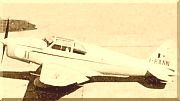
The Auster J/1U Workmaster is a late 1950s British single-engined single-seat high-wing agricultural monoplane built by Auster Aircraft Limited at Rearsby, Leicestershire. Of traditional high-wing layout, it carries 90 gallons of spray fluid in a tank beside the pilot, an extra seat being provided for a passenger. The Lycoming 0-360-A engine of 180 h.p. driving a McCauley v.p. propeller giving it ample power; and slotted ailerons and balanced tail controls providing good handling. Oversize tyres were fitted. Take-off run at 2,550 lb gross weight and cruising speed at 65 per cent power are respectively 180 yd and 88 miles per hour (142 km/h). Britten-Norman spray gear was provided by Crop Culture, and this company ordered nine Workmasters.
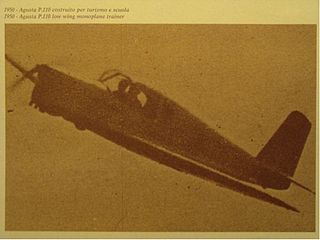
The Agusta CP-110, also known as CVV P.110 or Politecnico P.110, was a prototype Italian four-seat light aircraft first flown in 1951 that failed to attract interest from either civil or military operators, although it was evaluated by the Aeronautica Militare. Originally designed and built by the CVV -, production aircraft were to have been built by Agusta, but for lack of interest.

The Ambrosini SAI.7 was an Italian racing aircraft flown before World War II that entered production as a military trainer after the war. It was of conventional configuration, constructed of wood, with a tail-wheel undercarriage. Power was provided by an air-cooled, inverted inline engine, the Alfa-Romeo model 115 with 225 horsepower.

The Alfa Romeo 110 was an Italian four cylinder air-cooled inverted inline engine for aircraft use, mainly for trainers and light aircraft. The Alfa Romeo 110 was based on the de Havilland Gipsy Major, with approximately 500 units produced. Derivatives of the 110 include the -1, ter and Alfa Romeo 111.
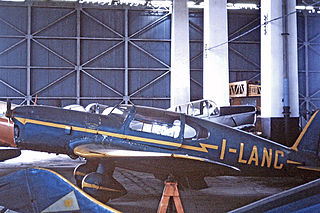
The Ambrosini SAI.2S was a four-seat light aircraft produced in Italy shortly before World War II.

The Ambrosini SAI.3 was a two-seat Italian touring airplane first flown in 1937.

The Ambrosini SAI.10 Grifone ("Griffon") was a military trainer aircraft produced in small numbers for the Italian Regia Aeronautica early in World War II.

The Ambrosini SAI.403 Dardo ("Dart") was a light fighter aircraft built in Italy during World War II.

The Aubert PA-20 Cigale, PA-204 Cigale Major and PA-205 Super Cigale were a family of high-wing cabin monoplanes built in France in the years immediately before and immediately after World War II. The original Cigale was shown at the 1938 Paris Salon but its development was interrupted by the War. The Cigale was a high wing cantilever monoplane of conventional configuration with fixed, tailwheel undercarriage.

The Avro 701 Athena is a British advanced trainer aircraft built by Avro in the late 1940s. It was designed to replace the North American Harvard in the Royal Air Force, but was bought only in small numbers, the competing Boulton Paul Balliol being preferred.
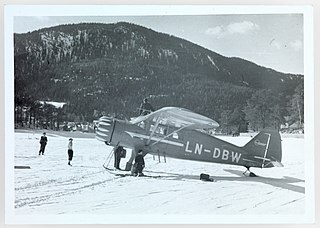
The Widerøe C.5 Polar, sometimes known as the Honningstad C.5 Polar, was a Norwegian general-purpose land or floatplane built by Widerøes Flyveselskap.

The Colonial Model C-1 Skimmer was an American small single-engined amphibian flying boat built by the Colonial Aircraft Corporation. It was the start of a line of very similar aircraft designed by David Thurston.

The Piaggio P.148 was a 1950s Italian two-seat primary or aerobatic training monoplane designed and built by Piaggio Aero.

The Fiat G.46 was a military trainer developed in Italy shortly after World War II.

The Macchi MB.308, later Aermacchi MB-308, is a light aircraft produced in Italy in the late 1940s.

The SAI KZ IV was a light twin-engined aircraft first built in Denmark in 1944 for use as an air ambulance.

The SAI KZ VII Lærke was a light utility aircraft built in Denmark shortly after the Second World War. Based on the SAI KZ III air ambulance, the KZ VII was a strut-braced, high-wing monoplane of conventional design with an enclosed cabin for four seats. Fifty-six aircraft were built, and another 22 partially completed aircraft were destroyed in a factory fire in 1947. The Danish Air Force operated 10 of the type as trainers between 1950 and 1977.

The Sparmann S-1 was a 1930s Swedish military training monoplane, designed by Edmund Sparmann, built in small numbers for the Swedish Air Force. The S-1 was a single-seat low-wing braced-monoplane with a fixed trail-skid landing gear. It was powered by a single 130 hp (97 kW) de Havilland Gipsy Major engine.

The Ambrosini Rondone is an Italian-designed two/three-seat light touring monoplane of the early 1950s.
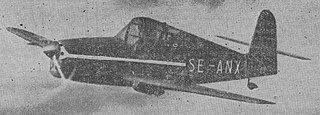
The Skandinaviska Aero BHT-1 Beauty is a 1940s Swedish single-seat light monoplane designed by E. Bratt, K.E. Hilfing and B.Törnblom and built by Skandinaviska Aero of Stockholm.
